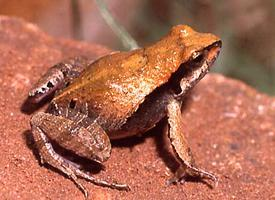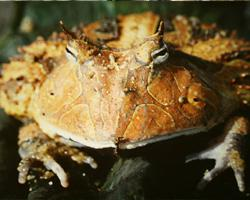
Váhy a míry
| Délka | od 3 do 4 cm |
|---|
Popis zvířete
The Cuyaba dwarf frog, scientifically known as Physalaemus nattereri, is a fascinating and unique species of frog that belongs to the Leptodactylidae family. This small amphibian is native to parts of South America, particularly found in Brazil, Bolivia, Paraguay, and Argentina, thriving in a variety of habitats that range from moist savannas to arid caatingas, showing a remarkable adaptability to different environmental conditions.Physalaemus nattereri is characterized by its diminutive size, which is where the term "dwarf" in its common name comes from. Adults typically reach only about 25 to 30 millimeters in length, making them quite small compared to many other frog species. Their skin color can vary widely, including shades of brown, gray, and green, often with darker patches or spots that provide camouflage against the forest floor and leaf litter, aiding in their survival by hiding them from predators.
One of the most distinctive features of the Cuyaba dwarf frog is its breeding call, which is unlike that of most other frog species. The males produce a unique, high-pitched peeping sound, which they emit to attract females during the mating season. This call is made possible by a specialized vocal sac that inflates and deflates as they call, a fascinating adaptation that showcases the diversity of amphibian communication.
The reproductive habits of Physalaemus nattereri are also noteworthy. Breeding typically occurs during the rainy season, when temporary pools of water form, providing the perfect environment for laying eggs and the development of tadpoles. Females lay their eggs in these temporary pools, where they are fertilized externally by the males. The eggs hatch into tadpoles, which undergo a rapid development, transforming into adult frogs before the temporary pools dry up, a cycle that is perfectly synchronized with their environment.
In terms of diet, the Cuyaba dwarf frog is insectivorous, feeding on a variety of small insects and other invertebrates. This diet is typical of many small frog species, which play a crucial role in controlling insect populations and thus maintaining the ecological balance within their habitats.
Despite its resilience and adaptability, the Cuyaba dwarf frog faces threats from habitat destruction and pollution, which are common issues affecting amphibian populations worldwide. The conversion of their natural habitats into agricultural land, urban development, and contamination of water bodies with pesticides and other chemicals pose significant risks to their survival.
In conclusion, the Cuyaba dwarf frog (Physalaemus nattereri) is a small, yet remarkably adaptable amphibian with unique characteristics and behaviors. Its presence in diverse habitats across South America, coupled with its distinctive breeding calls and reproductive strategies, make it an intriguing subject of study for herpetologists and nature enthusiasts alike. However, like many other amphibians, it faces challenges from human activities that threaten its survival, highlighting the need for conservation efforts to ensure the continued existence of this and other amphibian species.
Podobná zvířata
Nové fotografie zvířat
Top 10 zvířat
- Chinese water dragon (Physignathus cocincinus)
- Galápagos tortoise (Geochelone nigra complex)
- Dolphin gull (Leucophaeus scoresbii)
- Japanese macaque (Macaca fuscata)
- Colombian red howler (Alouatta seniculus)
- Sea urchins (Echinoidea)
- Moustached guenon (Cercopithecus cephus)
- Diana monkey (Cercopithecus diana)
- Common reed warbler (Acrocephalus scirpaceus)
- Common house mosquito (Culex pipiens)
